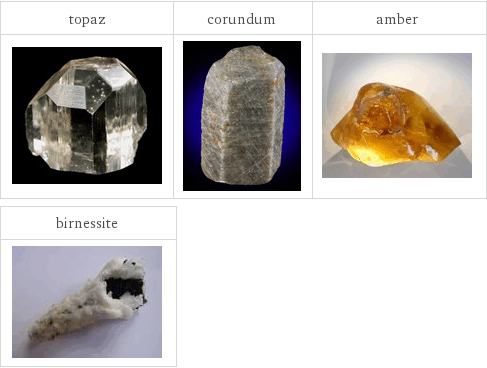Input interpretation

topaz (mineral) | corundum (mineral) | amber (mineral) | birnessite (mineral)
Images

Images
Wikipedia summary
Topaz

Topaz is a silicate mineral of aluminium and fluorine with the chemical formula Al_2SiO_4(F, OH)_2. Topaz crystallizes in the orthorhombic system, and its crystals are mostly prismatic terminated by pyramidal and other faces. It is one of the hardest naturally occurring minerals (Mohs hardness of 8) and is the hardest of any silicate mineral. This hardness combined with its usual transparency and variety of colors means that it has acquired wide use in jewellery as a cut gemstone as well as for intaglios and other gemstone carvings.
Corundum

Corundum is a crystalline form of aluminium oxide (Al 2 O 3) typically containing traces of iron, titanium, vanadium and chromium. It is a rock-forming mineral. It is also a naturally transparent material, but can have different colors depending on the presence of transition metal impurities in its crystalline structure. Corundum has two primary gem varieties: ruby and sapphire. Rubies are red due to the presence of chromium, and sapphires exhibit a range of colors depending on what transition metal is present. A rare type of sapphire, padparadscha sapphire, is pink-orange.
Amber

Amber is fossilized tree resin, which has been appreciated for its color and natural beauty since Neolithic times. Much valued from antiquity to the present as a gemstone, amber is made into a variety of decorative objects. Amber is used in jewelry. It has also been used as a healing agent in folk medicine.
Birnessite

Birnessite (Na_0.3Ca_0.1K_0.1)(Mn^(4 + ), Mn^(3 + ))_2O_4 · 1.5 H_2O is an oxide mineral of manganese along with calcium, potassium and sodium. It has a dark brown to black color with a submetallic luster. It is also very soft, with a Mohs hardness of 1.5. Birnessite is formed by precipitation in lakes, oceans and groundwater and is a major component of desert varnish and deep sea manganese nodules.